When Wendy Bedard, a Shelter Medical Assistant at Protectors of Animals (POA) in East Hartford, Connecticut, met Reed for the first time, she immediately noticed the injuries on the then-three-month-old kitten’s neck. “Reed was surrendered to Protectors of Animals in November 2018 with his brother Rascal,” explains Wendy. “His prior owner could no longer care for them due to a death in the family.”
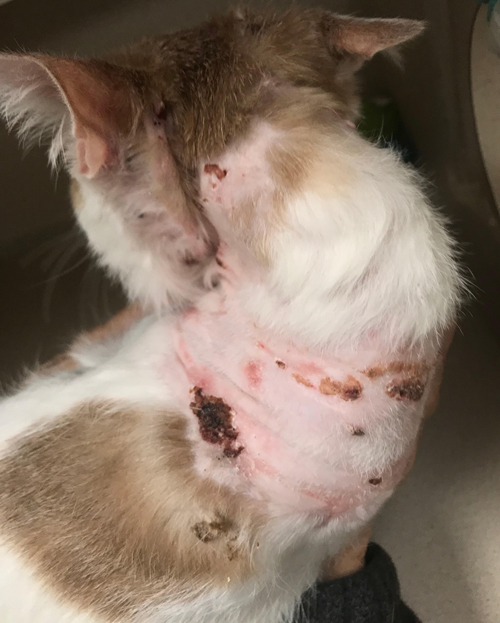
According to the pair’s former owner, Rascal was a bully and he was the one who was responsible for the wounds to Reed’s neck. Not wanting to subject the adorable ginger and white kitten to further trauma, Protectors of Animals separated the siblings by placing them with different foster families.

However, the injuries to Reed’s neck didn’t cease, proving Rascal was innocent of beating up his brother, but leaving everyone at the rescue both confused and concerned. “This was the most perplexing, frustrating, and exasperating time for POA and Reed,” says Wendy. “The severity of the wounds was escalating and the cause was unknown until his diagnosis in February 2019.”

In early 2019, Reed was diagnosed with feline cutaneuous asthenia (FCA), or Ehlers-Danlos syndrome (EDS), a group of connective tissue disorders. “Ehlers-Danlos syndrome is a rare genetic disorder passed from parent to offspring, which affects the levels of collagen in the body,” explains Wendy.
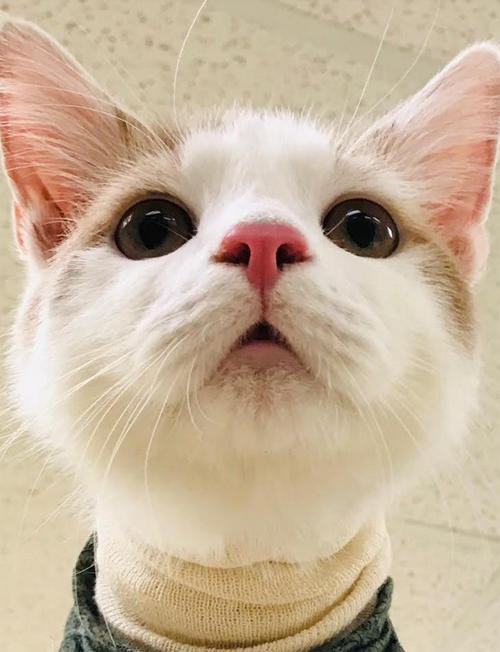
As a result, people and animals with EDS can have a number of different symptoms, including fragile, loose, and stretchy skin that is easily damaged and ligaments that are unusually lax and prone to tearing.

While everyone at Protectors of Animals was relieved to finally have an explanation for Reed’s mysterious injuries, it wasn’t long before they found the diagnosis had given them more questions than answers. “How could Reed have such a rare disorder and what does it mean for his quality of life?” Wendy remembers thinking. “Then the diagnosis brought despair. We were told that there are no cures or specific medical treatments to manage the disease. That is when our mission to learn, understand, and manage EDS for Reed began.”

Ehlers-Danlos syndrome, or feline cutaneous asthenia (FCA) as it is known when it affects cats, can be managed in a number of different ways, including with the help of protective clothing. Because a lot injuries to cats with EDS are self-inflicted, frequent nail trimmings are exceptionally important, and in some extreme cases, veterinarians may recommend declawing as a last resort.
View this post on Instagram
“Reed’s current Ehlers-Danlos symptoms are fragile skin and rear leg ligament issues,” says Wendy. “He has incurred several self-inflicted wounds on the neck, ears, and shoulder area, which, at times, require suturing and antibiotics.”
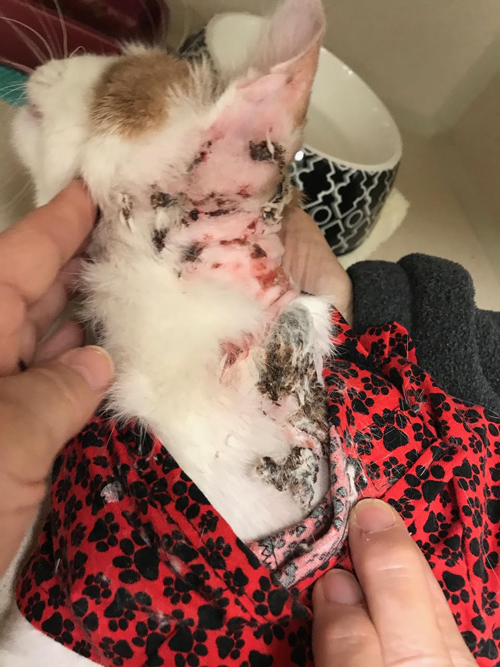
Determined to safeguard this incredibly cute kitten’s delicate skin, the rescue’s staff purchased several different outfits for Reed, some of which proved more successful than others. While Reed requires more care than the average kitten, his lax ligaments don’t impact his mobility, and he — and other cats with Ehlers-Danlos syndrome — are capable of living relatively normal lives.
View this post on Instagram
“Reed is still a kitten at eight months old, so he loves to run, jump, and play,” says Wendy. Because of Reed’s special needs, the staff at Protectors of Animals hoped to be able to find him a home with someone who has experience caring for a cat with Ehlers-Danlos syndrome, such as a veterinarian or veterinary technician.
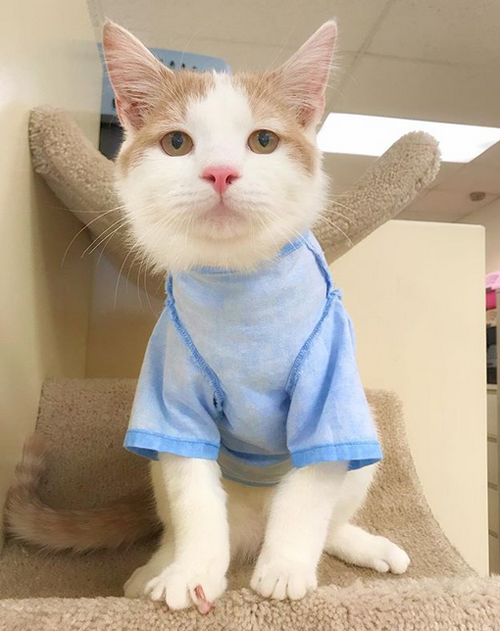
Incredibly, in late March 2018, this adorable boy caught the attention of Abby, a veterinarian who — like Reed — has Ehlers-Danlos syndrome! After their first meeting, Abby knew Reed was meant to be a part of her family, and everyone at the rescue agreed, allowing this remarkable vet to adopt this very special kitten.
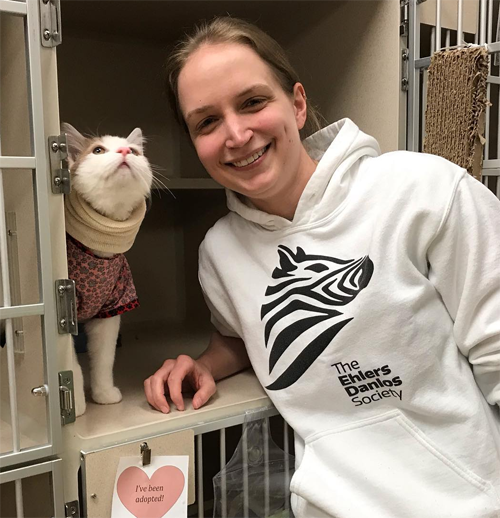
Just a couple of weeks later, Reed is enjoying life in his new home, and he’s bonding with mom and getting used to his new sister, a very curious and friendly Basset Hound. However, this handsome ginger and white boy is deeply missed by everyone at Protectors of Animals, the people who served as Reed’s caregivers and advocates when he desperately needed someone to help him get the care he needed.
View this post on Instagram
“When a diagnosis is made, euthanasia is often suggested,” explains Wendy. “We were not prepared to say goodbye to Reed as a result of the EDS diagnosis. We could not give up on Reed until all avenues were exhausted.” Thanks to the tireless work of the staff at Protectors of Animals, Reed is thriving in a safe and happy forever home with a mom who couldn’t be more perfect for him and his unique needs.

Even though Reed spent just a few months at the rescue, he left an indelible mark on everyone at POA, and they will never be able to forget his resilience and the way he inspired them to keep looking for answers in the face of adversity. “He represents the dedication of shelter volunteers who have researched and reached out to others via social media to gain knowledge and understanding of EDS,” says Wendy. “He has always been vibrant and full of kitten inquisitiveness, even with severe and infected wounds on his body. Reed represents hope.”
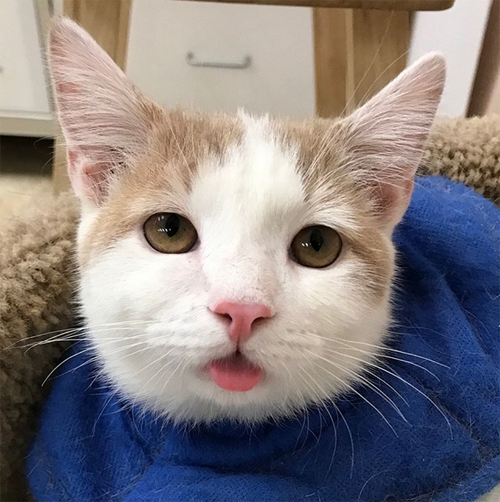
To learn more about this handsome boy, you can follow Reed on Instagram.



